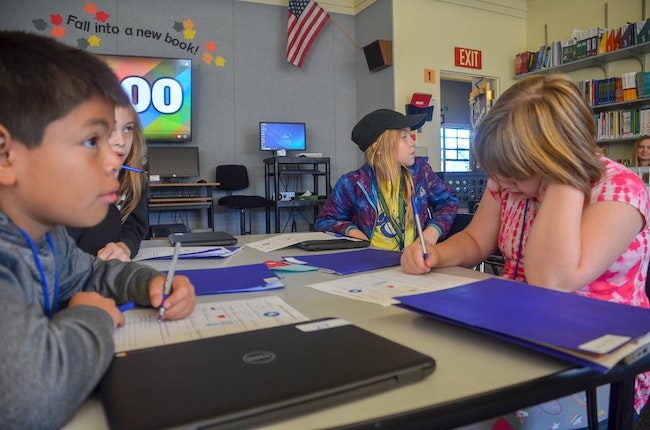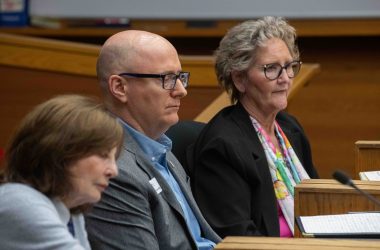 Jared Vergara Santana, left, Evelyn Francis, right, Iris Johnson, right back and Lillyana Green, back left, work on newspaper articles at Hoover Elementary School. (Rachel Alexander/Salem Reporter)
Jared Vergara Santana, left, Evelyn Francis, right, Iris Johnson, right back and Lillyana Green, back left, work on newspaper articles at Hoover Elementary School. (Rachel Alexander/Salem Reporter)
NOTE: Salem Reporter is providing free access to its content related to the coronavirus as a community service. Subscriptions help support this.
Salem-Keizer leaders are working overtime to cope with a slate of new mandates from the state as a school closure originally planned for two weeks extends to at least six.
“Last night, things changed dramatically again,” Superintendent Christy Perry told the Salem-Keizer School Board at the start of a special meeting Wednesday.
Oregon’s public schools are now scheduled to re-open April 28 under the latest directive from Gov. Kate Brown. Until then, about 41,000 local students will be at home or in daycare.
The Oregon Department of Education announced the extension Tuesday evening, and briefed Oregon superintendents on the change Wednesday morning. State officials advised the closure could be shortened, or lengthened, depending on guidance from public health agencies.
The closure is part of Oregon’s continuing effort to slow the spread of COVID-19, which public health officials estimate could infect 75,000 Oregonians in coming months. The state currently has 75 confirmed cases of the illness, including eight in Marion County. Three Oregonians have died from the illness.
Oregon schools will still receive state funding while closed so long as they comply with several state rules. Those include paying all staff during the closure, providing school meals and developing plans for student learning outside the classroom.
High school graduation for the Class of 2020 is the state’s priority, Perry said. State officials have said they’ll give districts guidelines starting next week, but Perry said her administrators have started planning.
“Right now, our schools are looking at every senior – are they on track for graduation, how many credits are they missing? If they didn’t have one more day of school, could we give them a diploma?” Perry told the school board.
Their first task is to determine what would happen if the state’s graduation requirements aren’t changed and work from there, she said.
District administrators in charge of curriculum are working to develop “resources for learning” to send out parents and guardians, district spokeswoman Lillian Govus said. Those assignments won’t be graded or required, but will give adults caring for children ways to keep them learning.
“These are not intended to replace classroom instruction,” Govus told the board.
Those resources will be on the district website by Monday, Perry said. Then, district leaders will call some teachers in to work to build specific materials for graduating seniors and more specific lessons.
No online instruction is planned in Salem-Keizer, and Education Department guidelines recommend against districts shifting to new online learning platforms during the closure. State and federal guidelines require that any online learning be equally accessible to students with disabilities and students learning English, a requirement many Oregon districts would struggle to meet.
State law requires a minimum number of instructional hours for students in kindergarten through high school. That requirement may be changed by the State Board of Education, which meets Thursday, March 19.
If the requirement isn’t modified, Salem-Keizer could seek a waiver for the days of instruction students are now missing, Perry said.
“We won’t be able to pull off instruction for a full 27 days of missed school in a way every student has access,” Perry said.
State officials are also looking at other waivers for federal education requirements, including standardized testing, which typically happens in the spring.
Some school districts will be required to provide childcare to the children of first responders and health care workers, state officials said this morning. Salem-Keizer administrators said they expect to be among them.
Assistant superintendent Kraig Sproles has reached out to Salem Health, fire departments in Salem and Keizer and other health and public safety agencies about the need for childcare. About 2,600 Salem Health employees have children under 11, Sproles told the school board.
“At this point we’re just trying to generate a list,” Sproles said.
School and food service employees are offering meals during the closure at 36 schools and gave out 11,000 meals Wednesday, up from about 2,000 on Monday.
“I don’t know where the numbers are going to settle. Every day they’ve increased,” Mike Wolfe, the district’s chief operations officer, told the school board.
He said the district has more flexibility from the state to waive normal school meal rules and is exploring ways to better serve families, including delivering meals directly to apartment complexes and producing food at schools rather than centrally, which would allow them to feed more students.
Salem-Keizer will now pay all regular employees their normal pay without the use of leave, spokeswoman Lillian Govus said. The plan for which employees will be on the job during the closure are still being worked out.
“We are going to have to call staff in to work – to meet childcare demand, to help with food, to help with supplemental learning,” Perry said.
Last week, district leaders said about 2,000 hourly workers, including bus drivers, classroom aides and school support staff, would have to use sick leave or other paid time off to make up for hours lost because of the closure. That sparked outrage from the Association of Salem-Keizer Education Support Professionals. New guidance from the state will allow the district to keep paying all workers.
Contact reporter Rachel Alexander at [email protected] or 503-575-1241.

Rachel Alexander is Salem Reporter’s managing editor. She joined Salem Reporter when it was founded in 2018 and covers city news, education, nonprofits and a little bit of everything else. She’s been a journalist in Oregon and Washington for a decade. Outside of work, she’s a skater and board member with Salem’s Cherry City Roller Derby and can often be found with her nose buried in a book.









